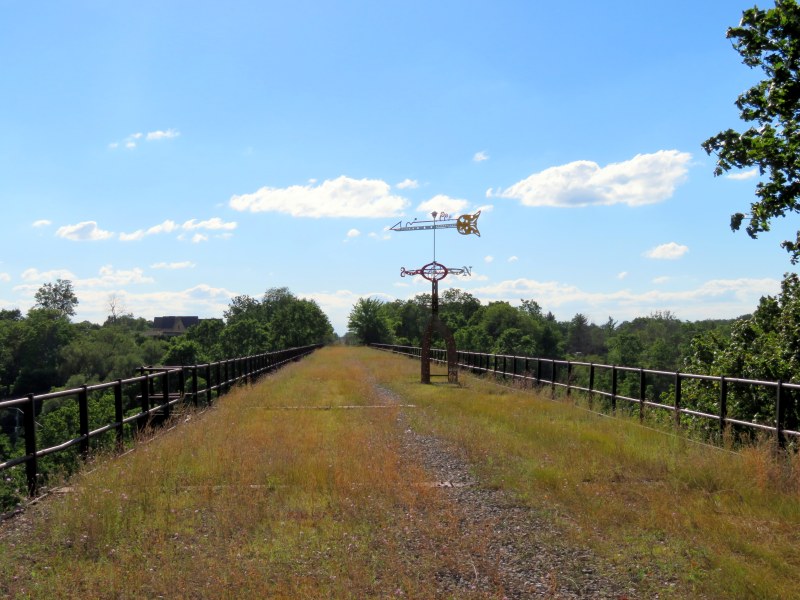Brockville and St. Thomas are two small Ontario industrial cities that wouldn’t normally attract much attention. But both communities are working on remarkable projects that re-purpose former railway infrastructure to create interesting public spaces that don’t just lure out-of-town visitors, but add a significant asset to be enjoyed by the entire community. The St. Thomas Elevated Park and the Brockville Railway Tunnel are the type of local, community-driven projects that I can get excited about.
St. Thomas likes to call itself the Railway Capital of Canada. One hundred years ago, five separate railway companies served the city. The Canada Southern (CASO) Railway, later purchased by the Michigan Central Railroad (which became part of the New York Central empire), built its headquarters and shops here; its double-tracked corridor was the fastest route between Buffalo and Detroit. St. Thomas was a stop on the London and Port Stanley Railway, a busy electric railway that ran regular passenger services until 1957. On the edge of town is the Jumbo monument, near the site where the famous Barnum and Bailey circus elephant was killed during a train stop.
 Jumbo Monument, at the westerly entrance to Downtown St. Thomas
Jumbo Monument, at the westerly entrance to Downtown St. Thomas
 The 1873 Canada Southern Station. The tracks it once served have disappeared.
The 1873 Canada Southern Station. The tracks it once served have disappeared.
Today, most lines into St. Thomas are abandoned, including the once-mighty Canada Southern; major rail customers such as Ford Motor Company closed local factories. The last passenger train, Amtrak’s Niagara Rainbow, departed from St. Thomas in 1979. The Port Stanley Terminal Railway runs tour trains along part of the old L&PS route, but its trains — for now — only board in Port Stanley.
Despite the loss of the railways, St. Thomas has retained much of its railway heritage. The Elgin County Railway Museum has made its home in the old Michigan Central shops. The station building still stands too — built in 1873, it is one of the longest stations in Canada, extending 108 metres. It was recently renovated and houses offices and retail businesses. A replica of the LP&S station was built downtown, with the hopes of accommodating Port Stanley-bound tour trains. Just west of Downtown St. Thomas is the Kettle Creek Viaduct, which is slated to become a new signature park.
 Kettle Creek Viaduct, the future St. Thomas Elevated Park, in August 2017
Kettle Creek Viaduct, the future St. Thomas Elevated Park, in August 2017
The Kettle Creek Viaduct, which is slated to become St. Thomas Elevated Park, is 9 metres wide and 260 metres long. It was completed in 1930 by the Michigan Central, the third railway structure on the site, soaring as much as 33 metres above ground level. The viaduct was made redundant when freight train service ended on the CASO Subdivision in 2006. Luckily, it was left standing; the local community is working on landscaping and accessibility improvements before it fully opens to the public.
Organizers envision many uses for the park, including walking, cycling, picnics, music and performances, decorated with public art and gardens. It’s an exciting project for St. Thomas, which has been hit hard by the loss of industry in southwestern Ontario. The obvious inspiration is New York City’s High Line, but the setting — and the intended programming — is unique to the local context.
I look forward to visiting St. Thomas again once work is complete on the Elevated Park: despite previous hopes of a 2017 completion, lots of work still needs to be done.
 Display board illustrating the plans for St. Thomas Elevated Park
Display board illustrating the plans for St. Thomas Elevated Park
Brockville, in Eastern Ontario, was also an important railway centre. In 2017, it also re-purposed an abandoned railway line. But unlike St. Thomas’ Kettle Creek Viaduct, Brockville’s new public space can be found underground.

Entrance to the Brockville Railway Tunnel with City Hall above
The Brockville and Ottawa Railway opened in 1859, one of the first railways to open in Ontario. In 1860, it built a tunnel under Downtown Brockville, which is on a hill above the St. Lawrence River. Canada’s first railway tunnel allowed the Brockville and Ottawa to route its trains direct to the waterfront and a ferry to New York State.
The Brockville and Ottawa later became part of the Canadian Pacific Railway network, and much of the original line remains in service, carrying VIA trains between Toronto and Ottawa. But the tunnel closed in 1970, and was sealed off. The busy Grand Trunk Railway is now CN’s Toronto-Montreal mainline, and several VIA trains a day stop at Brockville. Unlike St. Thomas, where most railway activity has disappeared, railways remain very important to Brockville.
 VIA Rail Train at Brockville Station, which has served trains between Toronto, Montreal and Ottawa since 1871
VIA Rail Train at Brockville Station, which has served trains between Toronto, Montreal and Ottawa since 1871
On August 12, 2017, the Brockville Railway Tunnel fully opened to the public after two years of construction and a long fundraising campaign. A few weeks ago, my wife and I made a day trip out to see the tunnel (and visit a friend of mine now living in Eastern Ontario); we took the train to and from Toronto. We were both very impressed, and have hopefully inspired a few others to visit (a friend of ours did make the same trek soon after us).
 Inside the Brockville Tunnel
Inside the Brockville Tunnel
The 525-metre long tunnel is free to visit and is open daily from 9:00 AM to 9:00 PM, at least into November; it will close during the winter months, potential special events excepted.
The tunnel is lit with programmed LED lights, which alternate between gentle changes of colour, or flash patterns, such as the occasional simulation of a train passing through. Speakers installed at regular intervals play Canadian rock standards, featuring artists such as Kim Mitchell, the Barenaked Ladies and the Tragically Hip. There are also occasional surveillance cameras and emergency call boxes. Groundwater seeps through the tunnel walls and drips from above.

Another section of the Brockville Railway Tunnel
The south portal opens on to Brockville’s waterfront park, near City Hall. While the north portal is open, landscaping and pathways are not yet complete. The long term plan is to build a new park on the north side, and extend the trail under the CN mainline, connecting the tunnel to the city’s system of multi-use paths, called the Brock Trail. Bicycles, skateboards, and inline skates are permitted in the trail, but only at walking speed.
The new park and event space on the north end will including a lookout to the CN mainline, where rail fans can watch and photograph freight and VIA passenger trains pass by. The enclosed event space, built to resemble a railway roundhouse, will host community events and craft markets.
 Long term plans for the Brockville Railway Tunnel
Long term plans for the Brockville Railway Tunnel
The Brockville Railway Tunnel is one of several places to visit in Brockville, which has an intact Victorian-era downtown, with several noteworthy buildings, including the 1843 Leeds & Grenville County courthouse, designed by Toronto architect John Howard. Courthouse Square is well-landscaped, and the waterfront is quite lovely.
It is encouraging to see how Brockville and St. Thomas have re-imagined disused railway infrastructure to create unique and interesting public spaces. They not only attract visitors to smaller cities, but are nice assets that benefit the local community.
